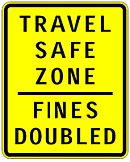907.3 Travel Safe Zones
| Worksheet |
| Travel Safe Zone Plan Worksheet |
907.3.1 Definition
A Travel Safe Zone (TSZ) is a highway safety countermeasure used to decrease crashes through increased law enforcement efforts. A TSZ allows law enforcement to issue double the normal fines for traffic violations on a segment of roadway that is designated as a TSZ. To be designated a TSZ, a highway safety analysis must demonstrate that fatal or disabling motor vehicle crashes exceed a predicted safety performance level for comparable roadways. TSZs must be clearly signed and have a specified begin date and end date to be enforced. Please see Missouri Revised Statute Section 304.590 for more information related to TSZs.
907.3.2 Signing
The TRAVEL SAFE ZONE – FINES DOUBLED sign (W26-1) grabs the attention of travelers and designates the beginning of a TSZ. Refer to Table 903.6.3 Warning Sign and Plaque Sizes to determine the proper dimensions of the TRAVEL SAFE ZONE – FINES DOUBLED sign.
The FINES DOUBLED ENDS sign (R2-20) marks the end of a TSZ. The FINES DOUBLED ENDS sign are 36 in. (wide) x 30 in. (tall).
907.3.3 Procedure
Steps:
1. Identify study/project limits:
- Establish a clear begin point and end point for the proposed TSZ.
- TSZ length should be minimized to maximize effectiveness.
- • A maximum TSZ length of 5 miles is suggested but may be exceeded if engineering judgment deems necessary.
- • A minimum of 1 mile is required.
- Establish a clear begin date and end date for the proposed TSZ.
- The TSZ timeframe should be minimized to maximize effectiveness.
- • A maximum TSZ timeframe of 2 years is suggested but may be exceeded if engineering judgment deems necessary.
- It is recommended to work closely with the regional Blueprint Coalition and local jurisdictions (police departments, highway patrol, and city/county entities) in developing the TSZ plan.
2. Complete a safety analysis for the project limits:
- A safety analysis should be performed to determine if fatal and/or disabling motor vehicle crashes exceed a predicted safety performance level for comparable roadways.
- This analysis should utilize Highway Safety Manual (HSM) methodologies, if adequately addressed in the HSM.
3. Develop full TSZ proposal:
- It is recommended to review possible engineering solutions as well as public information plans and incorporate these along with a law enforcement plan.
- It is recommended to utilize both law enforcement and public outreach in an effort to decrease crashes at the TSZ location.
4. Present proposal:
- A completed TSZ plan should be presented to the regional Blueprint Coalition for review.
- The review is recommended in order to facilitate coordination between the law enforcement plan, public information plan, and any engineering solutions (if necessary).
- A clear begin date and end date should be conveyed to all involved parties.
5. Fill out the Travel Safe Zone Plan Worksheet:
- The Travel Safe Zone Plan Worksheet should be filled out and the finalized plan should be sent to Central Office Highway Safety and Traffic (Traffic Safety section).
- This should be input into TMS by the Traffic Safety Section.
6. Order all relevant signing:
- All relevant signing should be ordered and installed prior to the begin date of the TSZ.
7. Monitor TSZ:
- District staff should periodically monitor the crash history of the TSZ to evaluate effectiveness.
- Monitoring should be done on a quarterly or biannual cycle.
- Any updates should be passed along to the regional Blueprint Coalition at the following meeting.
8. Post-TSZ Evaluation:
- After the TSZ has ended, a safety analysis should be done to determine the effectiveness of the TSZ countermeasure.
- Note: Crash data is lagged and may not be available for the TSZ site. It may be possible to contact the Traffic Records section of the Highway Patrol to determine the crash history of this area during the TSZ timeframe.
- Present the post TSZ evaluation to the regional Blueprint Coalition and recommend the TSZ be continued or disbanded.
- If no action is taken to continue the TSZ, it should be considered "disbanded" as of the "end date".
- The TSZ should be disbanded if the safety analysis shows that the intended purpose was met by the TSZ countermeasure.
- If the TSZ is to be disbanded, all signs should be removed immediately after the TSZ termination has been confirmed.
- The TSZ may be continued if the safety analysis shows that the intended purpose was not met by the TSZ countermeasure.
- If the TSZ is to be continued, a new plan should be developed and all steps of this procedure should be repeated.
- After two consecutive TSZ continuations, other engineering, enforcement, or educational countermeasures should be pursued.
907.3.4 Recommendations
TSZs should have a minimum length of 1 mile.
Work closely with the regional Blueprint Coalition as support from law enforcement is an integral part of making a TSZ effective. Additionally, the traveling public needs to know this has been designated an area of concern.
Depending on the predetermined timeframe of the TSZ, the regional TSZ team (comprised of engineering, law enforcement, and public information individuals) should conduct periodic monitoring of its safety performance.
Although local ordinances are not required to install a TSZ on the state highway system when the speed limit for that portion of the highway is established by state statute, MoDOT should not discourage the use of ordinances. Each municipality shall determine whether the municipality requires a local ordinance. An ordinance may be required if the speed limit within the TSZ is already established by ordinance.

